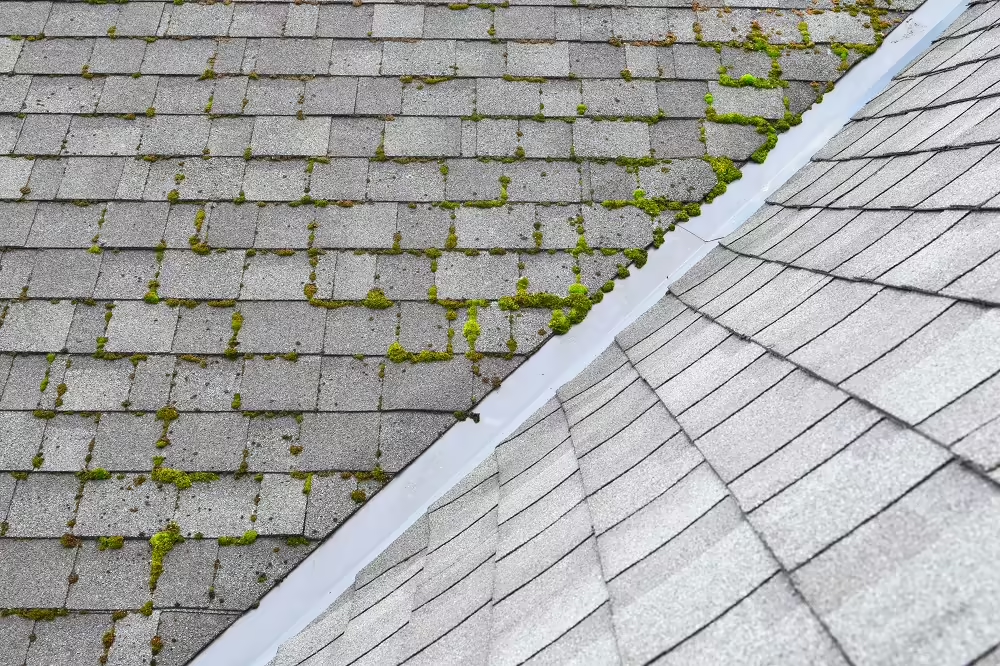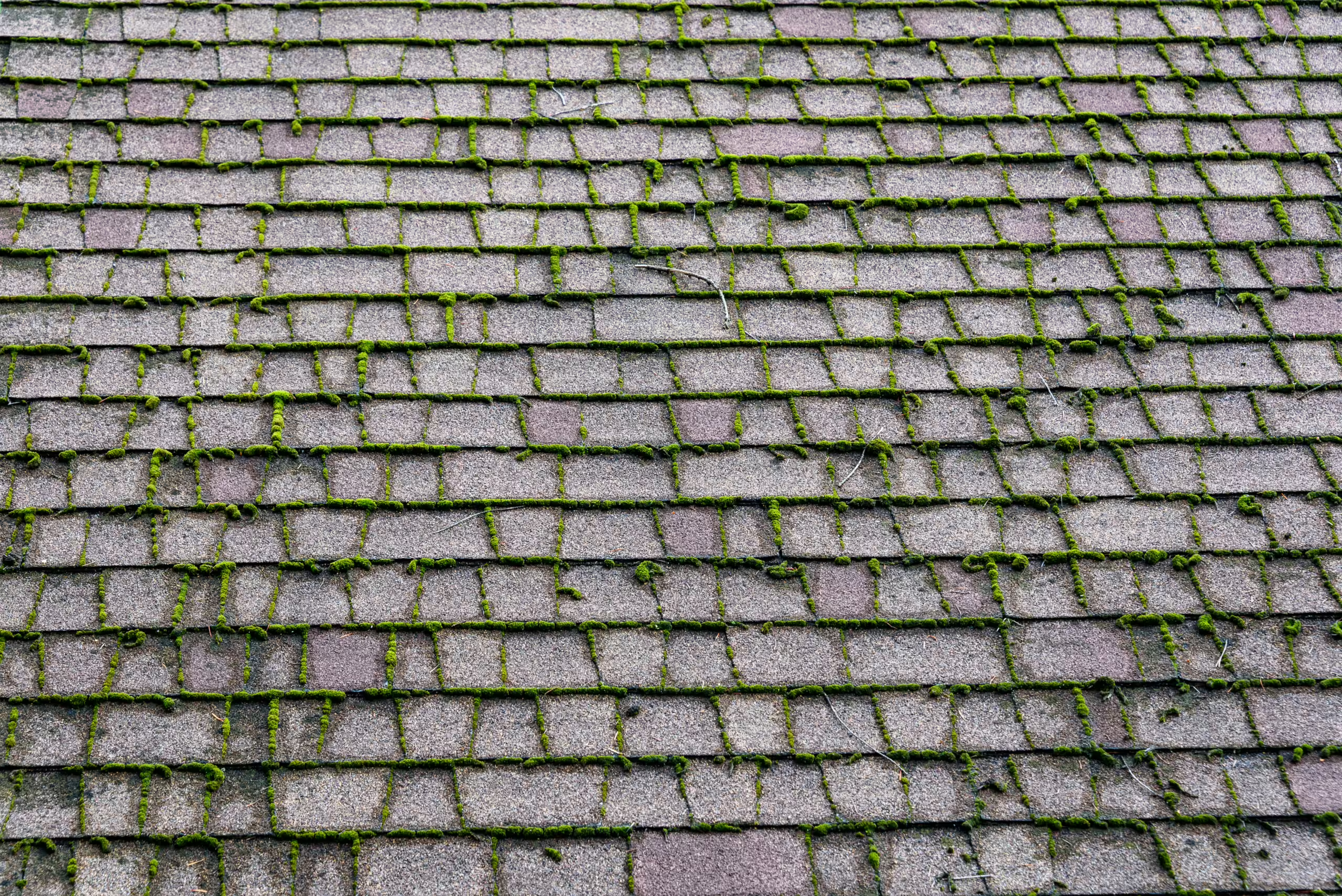Have you noticed unsightly growth on your roof? It is essential to determine whether it is moss or algae. While they may look similar, there are key differences between the two.
Moss is a plant that thrives in damp, shaded areas, forming a thick, spongy layer that can damage your shingles if left untreated. In contrast, algae are single-celled organisms that grow in warm, humid conditions, usually appearing as green or black streaks on your roof.
Understanding how to distinguish between moss and algae is crucial for proper roof maintenance. We will explore their characteristics, potential roof damage, health risks, prevention and treatment methods, and address frequently asked questions.
Moss on Your Roof
Moss is a common plant organism that grows on various surfaces, including roofs. It thrives in damp and shaded areas, making roofs an ideal environment for its growth. Moss reproduces through spores, which are easily carried by wind or animals and can land on your roof.
Once the spores find a suitable surface, they begin to grow and form a moss colony. Mosses are non-vascular plants, meaning they lack roots, stems, and leaves. Instead, they absorb water and nutrients directly through their leaves. This allows moss to cling tightly to surfaces, including roofs.

Moss appears as a thick, green, carpet-like layer. It often grows in shaded areas or on roofs that receive less sunlight, such as those under trees or in areas with high humidity. Moss can be unsightly, which is a concern for homeowners looking to maintain their roof’s aesthetic appeal.
While moss may seem harmless, it can cause potential damage if left untreated. Moss retains moisture, leading to water retention on the roof’s surface. This prolonged moisture exposure can weaken roofing materials, such as shingles or tiles, resulting in leaks or structural damage.
Moss can also trap debris, leaves, or other organic matter, clogging the drainage system of your roof. This blockage can prevent water from properly flowing off the roof, leading to ponding or additional moisture-related issues including leaks.
Algae on Your Roof
Algae is a single-celled organism and thrive in damp and shaded areas. On roofs, algae tend to form in areas with excess moisture, such as in regions with high humidity or where rainwater tends to accumulate.
There are several types of algae that can affect your roof, with the most common being blue-green algae, also known as cyanobacteria. This type of algae appears as dark green or black streaks on the roof’s surface. Another type is green algae, which is often lighter in color and forms as patches or a thin layer on the roof.
Algae growth on your roof may not cause immediate damage, but it can have long-term effects on its lifespan. The dark pigmentation of algae absorbs more heat from the sun, leading to increased temperatures on the roof’s surface. This heat can accelerate the deterioration of roofing materials, especially asphalt shingles. Additionally, algae can trap moisture on the roof, promoting the growth of moss and lichen, which can cause further damage.
Distinguishing Between Moss and Algae
Moss and algae are common growths on roofs, especially in areas with high humidity or shade. While they may seem similar, they have distinct physical characteristics that can help you determine whether your roof is affected by moss or algae.
Moss is a non-vascular plant that thrives in damp and shaded environments. It typically appears as a dense, velvety green covering on the roof. Mosses have leaf-like structures, called leaves, which are usually small and scale-like. They reproduce through spores and can accumulate in areas where moisture is trapped, such as on the north-facing side of the roof.
Algae, on the other hand, are simple organisms that belong to the plant kingdom. They are photosynthetic and can range in color from green to yellowish-green, black, or even red. Algae growth on roofs often appears as streaks or patches and can be slimy or slippery to the touch. Unlike moss, algae do not have leaves or roots and rely on moisture and sunlight for survival.
Potential Roof Damage and Health Risks
Moss and algae growth on your roof not only affects its appearance but can also pose potential risks to both your roof’s structural integrity and your health.
Moss, a type of small plant, thrives in damp and shaded areas. It has root-like structures that penetrate and lift roof shingles, leading to water infiltration and potential leaks. Algae, a green or black organism, forms unsightly stains and streaks on your roof’s surface. While algae itself may not damage your roof, it can retain moisture, creating a favorable environment for moss growth.
Apart from compromising your roof’s structural integrity, moss and algae can also have health implications. The damp environment created by these organisms can contribute to the growth of mold and mildew, which can trigger respiratory issues and allergies. Additionally, moss-covered roofs can become slippery when wet, posing a risk of falls and injuries for both homeowners and maintenance professionals.
Preventing and Treating Moss and Algae Growth
Moss and algae growth on roofs can be a frequent problem for homeowners. Not only do they impact the aesthetic appeal of your home, but they can also cause potential damage if left untreated. Fortunately, there are effective methods to prevent and treat moss and algae growth on your roof.
To prevent moss and algae from taking hold on your roof, keep your roof clean and free from debris. Regularly removing leaves, branches, and other organic matter will help minimize the conditions that moss, and algae thrive in. Trimming overhanging branches can also reduce shade and moisture, making it less favorable for their growth.
Another effective prevention method is the installation of zinc or copper strips along the roof ridge. When rainwater comes into contact with these metals, it creates a natural barrier that inhibits moss and algae growth. This environmentally friendly solution can be a long-term prevention strategy.
When treating existing moss and algae, choose safe and environmentally friendly options. Chemical treatments may be effective, but they can also harm the environment and surrounding vegetation. Instead, opt for biodegradable and non-toxic treatments specifically formulated for moss and algae removal. These treatments are designed to kill and remove moss and algae without causing any harm to your roof or the environment.
Regular maintenance is crucial to keep your roof free from moss and algae. Inspect your roof at least twice a year and remove any visible signs of moss or algae promptly. Use a soft-bristle brush or a pressure washer set at a low setting to gently remove the growth. Be cautious not to damage the shingles or tiles during the cleaning process.
FAQ’s: Moss & Algae on a Roof
Are you concerned about moss and algae growth on your roof? Here are some frequently asked questions about dealing with these issues:
How to remove moss and algae from a roof?
Moss and algae can be removed from a roof using various methods. One common method is to use a mixture of water and bleach or a specialized roof cleaner. Apply the solution to the affected areas, let it sit for a while, and then gently scrub away the moss or algae using a soft brush or broom.
How bad is algae for a roof?
Algae growth on a roof may not cause immediate damage, but if left untreated, it can lead to more significant problems. Algae can retain moisture and create a conducive environment for other organisms, like moss, to grow. Over time, this can damage the roof’s surface and compromise its integrity. Additionally, algae can make your roof look unsightly and affect its overall curb appeal.
What are the first signs of algae?
The first signs of algae growth on a roof are usually dark streaks or discoloration. These streaks may appear green, black, or brown and are commonly found on the north-facing side or in areas with limited sunlight. If you notice any unusual stains or changes in the color of your roof, address them promptly to prevent further damage.
Contact DaBella for Your Next Roof Replacement
With our commitment to exceptional quality and customer satisfaction, we are the go-to choice for homeowners across the United States. Contact us today for a free quote by calling 844-DaBella. Our team of roofing experts will be happy to help you plan your next roof replacement project.
As a GAF Master Elite Roofing Contractor, we pride ourselves on delivering the highest standard of roofing services. This prestigious designation is only awarded to the top 2% of roofing contractors in the country. When you choose DaBella for your roof replacement, you can trust that you are working with the best in the industry.
One of the key concerns for homeowners regarding their roofs is the growth of moss and algae. Moss and algae can cause unsightly discoloration and potential damage to your roof. Our roof replacement services come with the GAF 25 & 30-year limited warranties against blue-green algae discoloration on qualifying GAF products. With these warranties, you can have peace of mind knowing that your new roof will remain free from algae discoloration for years to come.

